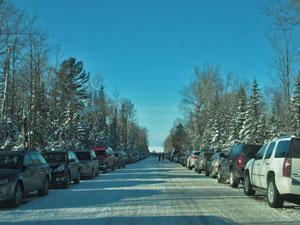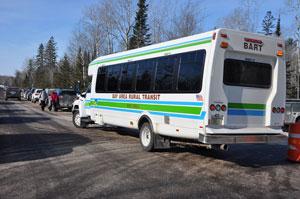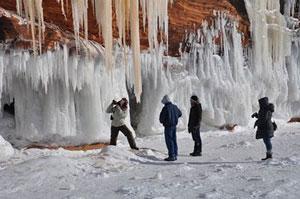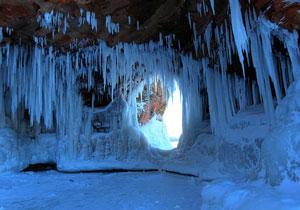For much of the country weary of the cold, the winter of 2014 can't end soon enough, but at Apostle Islands National Lakeshore, the combination of frigid conditions and word spread by social media has resulted in record visitation to the park. The draw? Sea caves, accessible only by boat in the summer, are festooned in ice in winter, and can be reached by walking across the now-frozen waters of Lake Superior.
This is the first year since 2009 that foot travel to what's called the "ice caves" has been possible. Rangers at the park keep a very close eye on ice conditions, and on January 15 of this year they announced that it was finally safe to travel across the ice from the mainland to the nearest caves.
Those familiar with the area welcomed the news, and as conditions remained favorable for visits to the caves, the word began to spread via social media. The result has been both an unprecedented tourist boom for this section of mainly rural Wisconsin'and a big challenge for the park staff.
Ice Viewers Set Visitation Records for the Park
On Saturday, February 15, an estimated 11,000 people visited the ice caves; that's a new single-day record for visits to the park, summer or winter. That number eclipsed the previous record of about 8,500 visits just a week earlier, and since over-ice travel opened a month earlier, an estimated 54,000 have visited the park's ice caves.
Just for a little perspective, the last month's visitation to the park equals over a third of the total for all of 2013, which was about 149,000 people.
If you've not been to the caves in person, or seen some of the photos posted on-line in recent days, you may be wondering what's behind all the fuss. If so, the images included with this story and the following video will give you just a small sample of the beauty to be found here.
It's great to be able to enjoy these dramatic natural features via photos, but those who want to see them in person have to be prepared to burn some calories, and for some, it's quite a workout.
At times like these, when the lake is sufficiently frozen, the ice caves nearest the mainland can be reached from a small parking lot at Meyers Beach, which is located about 18 miles west of the attractive community of Bayfield, Wisconsin. From that trailhead, the round-trip trek across the ice to the nearest cave and back is about two-and-a-half miles, but those who wish to go further to see more caves can end up covering a total of about six miles by the time they return to land. A map at this link shows the area, and the distance between Meyers Beach and the various caves.
The Length of the Hike Depends on Where You Park
As a result of the large crowds, however, there is the potential for a much longer walk to the caves and back, especially on weekends ... and that's created some safety concerns.
The crux of the issue is parking. The lot at Meyers Beach can hold about 50 cars, and that's usually adequate in more normal times. Demand in the past several weekends has been anything but normal, however, so once the lot fills, the next option is for visitors to park along both sides of Meyers Road, a cul-de-sac which runs for about 0.4 miles between Highway 13 and the lakeshore.

Parking spaces, especially on weekends, are at a premium. NPS photo.
When the shoulders of Meyers Road are also filled with vehicles, the overflow spills onto the sides of Highway 13. This map will allow you to visualize the area.
Last Saturday, a post at 1 p.m. on the park's Facebook page noted, "Cars now parking 4 miles back on Hwy 13. This makes a round trip walk of close to 12 miles! Sunset @5:30 today. Do you have enough time to do this safely today?!"
That was a very good question, and for some, the answer turned out to be "no." A later post from the park noted, "Too many people pushed the envelope today, starting out so late that they didn't make it back to the parking lot before it was dark."
Local Communities Pitch In To Help
The park and area communities are working together to ease the challenges posed by the unexpected crowds. Visitors, especially on weekends, are being encouraged to arrive early, or use shuttle services from alternative parking locations. A weekend Bay Area Rural Transit shuttle from the nearby village of Cornucopia costs $2; a ride to and from the Legendary Waters casino north of Bayfield runs $8. (Call 715-779-3712 for details.) Both shuttles drop off passengers at the junction of Meyers Road and Highway 13, which is about 0.4 miles from the lake access.

Using a shuttle bus from off-site parking can greatly shorten the total length of the hike from car to cave and back. NPS photo.
After last weekend's concerns with some visitors failing to allow enough daylight time to return to their vehicles, there are plans to end in-bound shuttles from remote parking to Meyers Road at about 2 p.m., with return trips back to remote parking running until 6 p.m.
The nearby Town of Bell has made a major contribution to the effort by plowing Meyers Road this winter. According to the park, "They plowed the right-of-way wide enough for us to park cars on both sides of the road last weekend. Without their help, Meyers Road would have been closed off this winter."
Other local support has come in the form of temporary, but very necessary, "facilities." A park spokesperson notes, "We'd like to express our thanks to the Ashland Area Chamber of Commerce and the Bayfield Chamber of Commerce and Visitor Bureau for covering the costs of the portable toilets installed at Meyers Beach to serve the mass of humanity that is presently coming to visit the ice caves. It's hard to enjoy the beauty when you have other pressing needs to attend to."
Other vital support has come from local emergency service providers, including the Bayfield Ambulance Service, which has made multiple trips to the area to transport individuals injured by slips and falls on the ice. On February 15, at least a dozen injured or missing persons required assistance of Park Rangers and area partners.
All of those injuries were caused by slips on the ice, prompting the park staff to remind visitors of the need to be cautious, as well as properly attired for over-ice travel. This page on the park website and a separate "FAQ" page include a wealth of important information for anyone contemplating a hike to the ice caves, including tips on safe footwear and other gear. These are "must reads" before you make the trip.

Here's a tip for visitors: Don't stand under large icicles and other hanging ice formations! NPS photo.
Park Staff Offers Some Important Tips
Park staffers also offer a couple of additional safety tips, gleaned from experience with the large crowds.
"If you come with a group, please stay together so no one gets separated from the rest of the party. Conditions can change quickly, and it's pretty slippery out there, especially under the rock overhangs. There were 11 injuries today and 1 major search for an overdue person."
"Rangers and EMTs would be grateful, and so would your mother. No one needs the anxiety of wondering if their loved one is OK out there on the ice. Cell coverage is spotty out there, and batteries draw down quickly in the cold, so you can't rely on phones to stay in touch or call for help."
An online search for photos of the ice caves will quickly turn up some dramatic photos of the frozen formations, and some of those were clearly taken from rather risky locations. This has prompted the staff to issue a safety plea that would seem to be common sense: "Do NOT stand directly under the large icicles and frozen waterfalls suspended from the top of the cliffs. They might break off and come crashing down at the most inopportune moment."
Ice Caves Heat Up the Local Economy
Comments posted on social media confirm that many of the recent visitors have found the trek across the frozen lake to the ice caves to be well worth the effort, and the recent flood of interest in the caves has been a boon to local businesses.
Cheryl O'Bryon, who runs an inn and restaurant in the area, told the Minneapolis Star Tribune, "It is definitely an economic miracle, there's no doubt about that. I'm staffed right now like I would be on the Fourth of July weekend. It's incredible."
Bruce Hoekstra, the proprietor of a B&B called Lucy's Place in nearby Bayfield, told the Traveler, "In the 16 years we've been doing this, we have not had a winter like this. For this last weekend, I could have filled every room three times. Some of the other lodging people that have normally been closed in the winter have opened up because of the demand."

The ice inside the caves includes a variety of shapes and colors. Photo by Rich Hoeg via Flickr and Creative Commons.
Mary Motiff, tourism director for Bayfield County Tourism, told the Duluth News Tribune the Ice Cave business "is generating between $5.6 million and $7.2 million for the economy of northern Bayfield County and the nearby city of Ashland. This is bigger than Apple Fest (the Bayfield Apple Festival),' Motiff said.
Budget Challenges for the Park
The boost for local businesses is a positive result of what could be accurately described as The Ice Cave Phenomenon, and while the park is benefitting from the increased publicity, the record-setting surge in visits is also posing its share of challenges for the staff'and this year's budget. Unlike commercial enterprises, the park doesn't receive a big boost in income from the increased crowds.
Neil Howk, the park's Assistant Chief of Interpretation, told the Duluth News Tribune that he "has never seen anything like this in his 30 years at Apostle Islands National Lakeshore. It's consuming pretty much everything right now,' Howk said. 'It's an all-hands-on-deck thing. The division chiefs are out parking cars.'
Howk said normal mid-winter staffing at the small park might see about six employees on weekend duty, but that number has grown recently to as many as fourteen employees. Rangers and other NPS staff from Grand Portage National Monument, Indiana Dunes National Lakeshore, Pictured Rocks National Lakeshore, and St. Croix National Scenic Riverway have also been called in to assist at Apostle Islands the last two weekends, but the funding for that help will likely have to come at the expense of summer staffing and activities.
The park has publically expressed its appreciation for other sources of help, including the Border Patrol, Bayfield County Sheriff's Office, State Police, U.S. Coast Guard Auxiliary, Great Lakes Indian Fish and Wildlife Commission, and numerous volunteers.
When Will It All End?
The park staff and jubilant local businesses probably have the same question: How long might the crowds keep coming?
That depends on the weather, and information posted by the park wisely notes, "This is impossible to predict. Wind, waves, and/or warmer temperatures will eventually break up the ice, but we don't know when that will happen."
For some sense of current conditions and the level of visitation, you can view recent photos of the ice in the area near the caves on the Sea Caves Watch website, which includes images taken hourly during the daytime.
If you're considering a trip to the park, be sure to check both the local weather forecast and the current ice conditions. A ice status report is available by calling (715) 779-3397 - extension 3.
That number has an appropriate name: it's dubbed the Ice Line.


 Support Essential Coverage of Essential Places
Support Essential Coverage of Essential Places







Comments
Here's an update from the park on Sunday night, and a reminder about the importance of checking current conditions before planning a trip to see the ice caves:
"Winter storm is coming tonight and tomorrow -- please think about road conditions and visibility (predicted to be down to 1/4 mile at times) on Monday [Feb 17]. The plow crew of the Town of Bell, which has done such a fantastic job keeping the road clear, probably won't get out there until they've cleared the streets of Corny. So an early Monday morning visit is NOT recommended. If it clears up in the afternoon, and the roads are clear, the fresh snow ought to be beautiful - snowshoes or skis will be the way to travel."